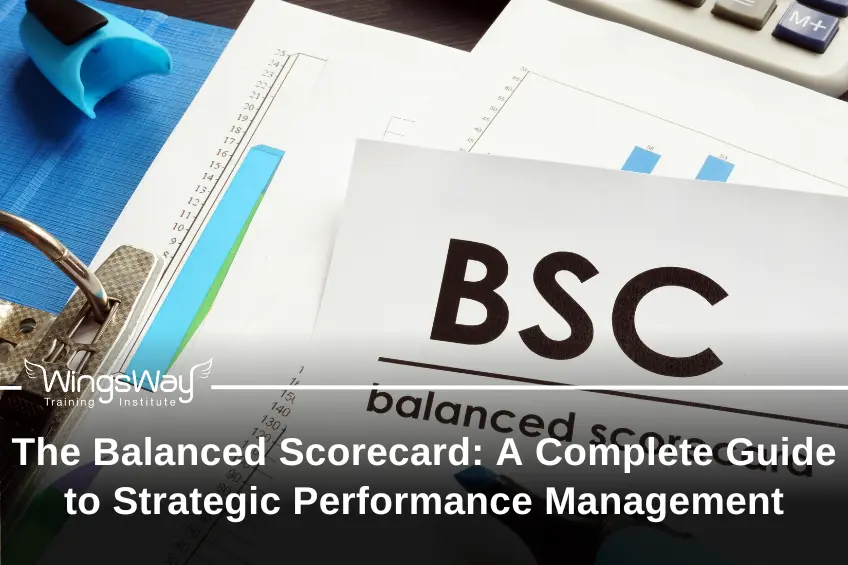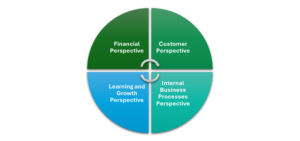
The Balanced Scorecard: A Complete Guide to Strategic Performance Management
Organisations today face unprecedented challenges in measuring and managing performance. Traditional financial metrics—such as profit margins, revenue growth, and return on investment—have long been the gold standard for evaluating business success.
However, these measures tell only part of the story, focusing primarily on past performance while offering limited insight into future potential.
The Balanced Scorecard (BSC) emerged as a revolutionary solution to this narrow view. At its core, the BSC is a strategic management framework that expands an organisation’s vision beyond financial indicators by incorporating three additional perspectives: customer satisfaction, internal business processes, and learning and growth.
This comprehensive approach enables leaders to align day-to-day operations with long-term strategic objectives, creating a balanced view that connects current actions to future outcomes.
To refresh the definition, a Balanced Scorecard (BSC) is a strategic planning and management system that organisations use to:
- Communicate what they’re trying to accomplish
- Align day-to-day work with strategy
- Prioritise projects, products, and services
- Measure and monitor progress toward strategic targets
Unlike traditional management systems that focus predominantly on financial controls, the BSC provides a framework that adds strategic non-financial performance metrics to financial measures, giving managers and executives a more “balanced” view of organisational performance.
Origins and Core Concept
Developed by Robert Kaplan and David Norton in the early 1990s, the Balanced Scorecard was first introduced in a Harvard Business Review article titled “The Balanced Scorecard—Measures That Drive Performance.”
Kaplan and Norton’s research revealed a critical insight: relying solely on financial indicators was like driving a car by only looking in the rearview mirror. These measures reported on outcomes but failed to identify the drivers of future performance.
Before the BSC, companies primarily focused on financial indicators like profit margins and return on investment, which only told part of the story—the results of past actions, but not what was driving future performance.
The BSC addressed this limitation by providing a forward-looking perspective that balances historical financial performance with the factors that drive future success. It translates an organisation’s mission and strategy into a set of measurable objectives across four key perspectives:
1. Financial Perspective:
The financial perspective addresses the traditional bottom line. It focuses on how the organisation’s strategy contributes to improving profitability, revenue growth, and shareholder value. Key metrics might include:
- Revenue growth and diversification
- Profit margins
- Return on investment (ROI)
- Cost reduction
💡 Why it matters: Financial metrics are still essential as they represent the ultimate outcome of your strategic decisions and show whether your business strategy is contributing to bottom-line improvement.
2. Customer Perspective:
This perspective examines how the organisation is perceived by its customers. It focuses on customer satisfaction, loyalty, and market share. Key metrics could include:
- Customer satisfaction scores
- Customer retention rates
- Market share in target segments
- Customer acquisition costs
💡 Why it matters: Happy customers lead to repeat business, positive word-of-mouth, and ultimately, financial success. This perspective helps you understand if your products and services are meeting customer needs.
3. Internal Business Processes Perspective:
This perspective focuses on the internal processes that drive customer satisfaction and financial performance. It aims to identify and improve critical processes that create value. Key metrics might include:
- Process efficiency and cycle time
- Quality control measures
- Innovation and new product development
- Operational efficiency
💡 Why it matters: Efficient, effective internal processes allow you to deliver value to customers while controlling costs. This perspective helps identify which operations need improvement to better serve customers and meet financial goals.
4. Learning and Growth Perspective:
This perspective focuses on the organisation’s ability to learn, innovate, and improve. It addresses the intangible assets that drive future performance, such as employee skills, knowledge, and organisational culture. Key metrics could include:
- Employee satisfaction and retention
- Employee training and development
- Information system capabilities
- Organisational culture and knowledge management
💡 Why it matters: Your people, systems, and organisational procedures are the foundation that supports all other perspectives. This perspective ensures you’re investing in your future capability to change and improve.
How is the Balanced Scorecard Different from KPIs
While Key Performance Indicators (KPIs) and the Balanced Scorecard are both performance measurement tools, they serve different purposes and operate at different levels within an organisation’s performance management system.
KPIs (Key Performance Indicators) are specific metrics that measure performance against predetermined targets in particular areas of business operation.
KPIs are individual instruments measuring specific aspects of performance, while the Balanced Scorecard is the entire dashboard that organises these instruments in a meaningful way to give you a complete picture of organisational health.
💡 Understand the key difference between KPIs and balanced scorecards as effective performance measurement tools.
Benefits of using the Balanced Scorecard method
- It helps in aligning organisational activities with its overall strategy, making sure everyone is working towards a shared goal
- It improves communication by creating a common language for discussing strategy and performance of the team
- It enhances performance measurement by focussing beyond financial metrics, on other key drivers of success and provides a complete picture
- improved decision making, which is based on a broader set of performance indicators
- Shifts focus from short-term financial gains to long-term sustainable growth
- accountability for performance across all levels of the organisation.
How to Create a Balanced Scorecard?
Creating an effective Balanced Scorecard involves three main steps:
1. Develop a Strategy Map
A strategy map is a visual representation of your organisation’s strategy, showing how objectives in the four perspectives connect to create value. It illustrates cause-and-effect relationships between different strategic objectives.
What is strategy mapping? Think of it as a road map that shows how improvements in learning and growth lead to better internal processes, which in turn improve customer satisfaction and ultimately financial results.
2. Select Metrics
For each objective in your strategy map, choose meaningful metrics that will indicate progress. Good metrics should be:
- Relevant to your strategic objectives
- Measurable with available data
- Actionable (you can influence the outcome)
- Easy to understand
3. Set Targets
Establish realistic but challenging targets for each metric. These targets should:
- Be specific and time-bound
- Reflect your strategic priorities
- Balance short-term and long-term goals
- Consider industry benchmarks and your organisation’s capabilities
Implementation Support for Balanced Scorecard
When implementing a balanced scorecard, professional guidance can help with:
- Developing customised strategy maps that reflect your unique business model
- Tailoring perspectives and metrics to your industry, strategy, and goals
- Setting realistic targets based on industry benchmarks and organisational capabilities
- Integrating the BSC with existing systems such as performance management and budgeting
- Establishing clear accountability for each metric
Finding the Balance
In conclusion, the BSC is a powerful management tool designed to help track and measure non-financial variables and a framework for organisations to translate their strategies into action and achieve sustainable success.
Rather than focusing solely on financial outcomes, the BSC helps leaders understand the drivers of performance and make better decisions for long-term growth.
In a world where intangible assets like customer relationships, employee knowledge, and innovation capabilities are becoming increasingly important, the Balanced Scorecard offers a more complete picture of organisational health and potential.
Our Experts Help You in BSC Implementation
At WingsWay Training Institute, we help participants to develop strategy map, tailor the perspectives and metrics as per the industry, strategy, and goals.
Set realistic targets and ensure to integrate with organisational systems such as performance management and budgeting with clear accountability.
If you wish to learn more about how to implement the BSC method in your organisation or receive balanced scorecard training, reach out to us.





